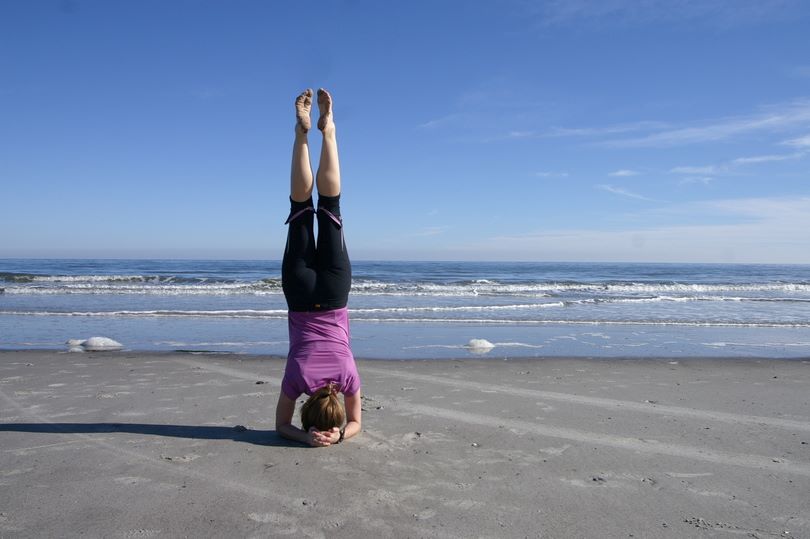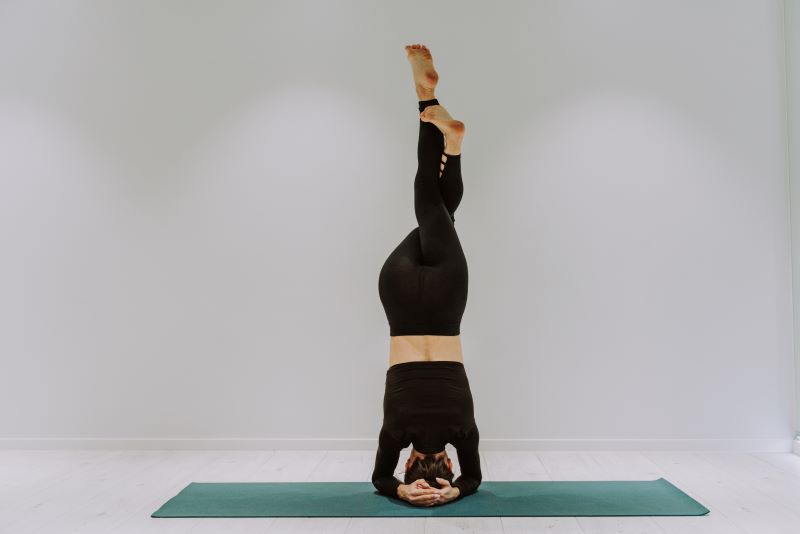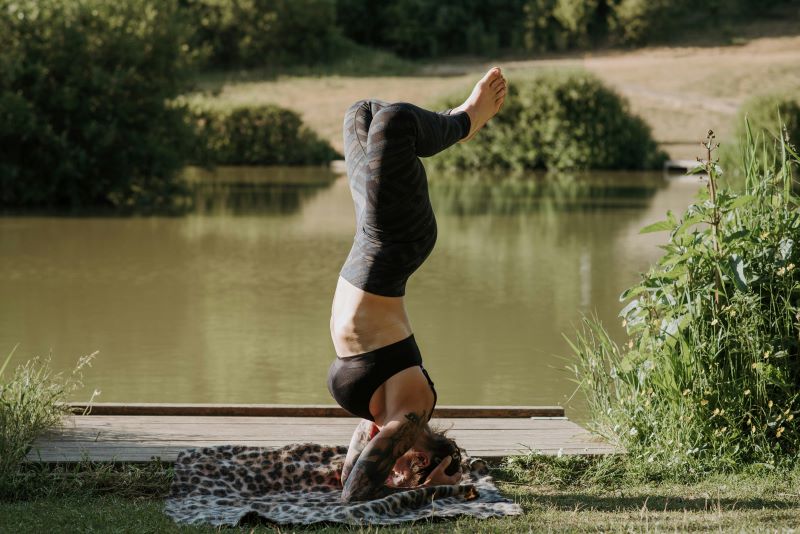15 Health Benefits of Shirshasana & How to Do It?

The headstand pose has a great many health benefits physically and mentally. It increases blood flow to the brain and therefore assists in improving concentration. This pose works on the upper body including the arms, shoulder and core muscles.
Shirshasana can reduce stress and mild depressive disorders and instil a sense of well-being. Reform may improve digestion and relieve menopausal symptoms. It is recommended that one understands the right method under a qualified trainer.

Table of Contents

What is Shirshasana?
Shirshasana is derived from the Sanskrit words ‘Shirsa’ meaning head and ‘asana’ meaning ‘posture’. This exercise is one of the most critical inversion exercises that allow blood flow to your brain and heart. Therefore, this refreshes your body's lymphatic and cardiovascular systems and keeps you energetic.
In this asana, you must comfortably place the head and forearms on the floor or mat. Then, you must clasp your hands and lift your legs slowly to support the whole-body weight by the head and forearms. However, if you are a beginner, you must consult a trainer to guide you before performing the pose.
How to Perform Shirshasana?

Shirshasana, also known as headstand, is an advanced yoga pose. Practice under expert guidance to avoid injuries and ensure effectiveness.
Here is a step-by-step guide on how you should perform the Shirshasana:
Step 1: Pull your heels below your hips and sit on your knees on the floor or a mat.
Step 2: Bring your forearm to the floor and close to your knees by holding the opposite elbows of your hands.
Step 3: Then, slowly stretch your arms forward and lock your fingers together.
Step 4: Gently place your head downwards on the floor or a mat and support it with your interlocked hands.
Step 5: Gradually lift your hips upwards and try to stretch and straighten your knees without moving your elbows or head.
Step 6: Until the back is straightened, walk a few steps ahead.
Step 7: Now, slowly bend your knee close to your chest. Repeat this with the other knee as well.
Step 8: Ensure that your heel aligns with your hips properly, resembling a half-headstand.
Step 9: Now, slowly stretch your knees upwards until you stand in an inverted pose.
Step 10: Try to balance yourself by using the strength of your shoulder and arms. Further, breathe steadily while practising this pose.
15 Health Benefits of Shirshasana
Shirshasana, or headstand, comes with numerous benefits, ultimately healing your body. The health benefits of Shirshasana include:
1. Helps to Relieve Stress
Shirshasana is highly beneficial if you have issues related to stress or anxiety. When performing a headstand, combine it with slow breathing to reduce stress. It is a cooling pose that allows you to draw your focus inward.
2. Improves Functioning of Pituitary Glands
The pituitary gland is important as it controls the mechanism of other glands, namely the thyroid gland and adrenal gland. Moreover, this yoga pose revitalises the central nervous system increasing blood flow into your brain. This, in turn, rectifies any glandular disorder and improves your brain function.
3. Increases Memory and Intellectual Capacity
Shirshasana involves blood flow into your head, thus boosting the function of your brain. This, in turn, improves willpower, focus, and concentration, thereby increasing memory and intellectual capacity.
4. Enhances Your Digestive System
As gravity reverses on your digestive organs, it initiates the removal of trapped gases from your abdomen, improving the digestive system. Moreover, this asana improves the flow of blood to all vital digestive organs. This, in turn, helps to improve the absorption of nutrients and revamp your health.
5. Improves Eye Health
As you perform this yoga, more oxygen-rich blood flows to your brain and ensures adequate nutrients and oxygen reach your eyes as well. Therefore, it helps to prevent any vision problems or macular degeneration.
6. Increases Blood Flow to Hair
A headstand or Shirshasana is an excellent pose if you want to enhance the nutrient flow to your scalp. As the nutrients reach your hair follicles, they will help in the growth of hair and improve the health of your hair too.
7. Improved Circulation
Shirshasana reverses blood flow, enhancing circulation throughout the body's systems.
This benefits cardiovascular health by promoting efficient blood flow and oxygenation.
Detoxification is also encouraged through improved circulation during the inversion.
8. Enhanced Focus and Concentration
Shirshasana stimulates the brain, promoting mental clarity. It improves cognitive function, aiding in productivity. Practising this pose regularly enhances overall focus and concentration abilities.
9. Strengthened Upper Body
Strengthening the upper body through practices like Shirshasana is vital for overall stability. This yoga pose particularly targets the shoulders, arms, and upper back, enhancing strength and endurance.
10. Increased Lung Capacity
Shirshasana expands lung capacity, enhancing respiratory function and oxygen intake. This leads to better overall lung health and improved stamina during physical activities. It improves oxygen delivery to muscles, leading to better performance and faster recovery.
11. Stimulated Endocrine System
Shirshasana stimulates the pituitary and pineal glands, regulating hormone production. This promotes overall hormonal balance, and various bodily functions effectively. It can help alleviate stress and improve mood by influencing the release of beneficial hormones like endorphins.
12. Boosted Immune System
Shirshasana enhances lymphatic drainage, boosting the body's defence against infections. It strengthens the immune system's ability to fight illnesses effectively. Additionally, a strong immune system can contribute to faster recovery times from illnesses and injuries.
13. Alleviated Headaches and Migraines
Shirshasana can alleviate headaches and migraines by increasing blood flow. This helps relieve tension in the neck and shoulders, often associated with headaches. Regular practice may contribute to reducing the frequency and intensity of headaches.
14. Emotional Balance
Shirshasana balances the nervous system, promoting emotional stability, clarity, and a sense of inner peace and harmony. It promotes inner peace and harmony, enhancing emotional well-being.
15. Increased Confidence
Mastering Shirshasana boosts self-confidence and self-esteem. Achieving and maintaining the pose requires focus and determination. The sense of accomplishment enhances overall confidence levels.
Other Benefits:
The other advantages of Shirshasana include:
Shirshasana strengthens your arms and shoulders as your hands are pushed firmly against the ground.
Prevents oedema or fluid development in your legs, ankles, and feet.
Stimulates the lymphatic system and removes toxins from your blood.
Headstand is a weight-bearing exercise that develops the core muscles and enhances your muscular endurance.
One of the major benefits of Shirshasana is that it energises and rejuvenates your body eliminating problems of sinus, cough, and cold.
As Shirshasana initiates blood circulation to your head, it keeps your mind calm and promotes sleep.
Types of Shirshasana
Shirshasana, or headstand, is a revered yoga pose known for its numerous variations. From classic to advanced forms, these variations cater to practitioners of all levels, offering diverse benefits.
1. Mukta Hasta Shirshasana

Mukta Hasta Shirshasana, or Free Hands Headstand, is a variation of Shirshasana. Where the hands are clasped behind the head, allowing for greater freedom in arm movement. This variation challenges balance and core strength.
2. Niralamba Shirshasana

Niralamba Shirshasana, or Unsupported Headstand, is an advanced variation.Where the practitioner balances solely on the head, arms resting by the sides. It demands exceptional strength, stability, and concentration.
Things to Know Before Doing Shirshasana Yoga
Shirshasana is an advanced yoga inversion that offers numerous benefits but requires careful preparation and caution. Here are essential considerations before attempting Shirshasana:
- Preparatory Poses: Prioritise preparatory poses that strengthen the upper body, core, and shoulders, such as the dolphin pose and plank pose. These poses build the necessary strength and alignment to support the body in a stable headstand position.
- Proper Alignment and Technique: Ensure proper alignment by placing the crown of the head on the mat with the arms forming a stable triangle base. Avoid excessive pressure on the head and neck by distributing weight.
- Gradual Progression and Patience: Practice patience and gradual progression when learning Shirshasana. Start with supported variations against a wall to build strength, confidence, and familiarity.
- Breath Awareness: Maintain deep and controlled breathing throughout the pose to stay calm and focused. Avoid holding your breath, which can increase tension and diminish balance.
- Duration and Rest: Respect your body's limits and avoid overexertion. Begin with short holds and gradually increase the duration as strength and comfort in the pose improve.
- Exit Strategy: Learn safe exit strategies to come out of Shirshasana gracefully and without strain. Practice controlled lowering of the legs or utilise a partner's assistance to return to a stable seated or kneeling position.
- Teacher Guidance and Supervision: Seek guidance from a qualified yoga instructor experienced in teaching inversions. Their expertise can provide personalised alignment cues, modifications, and proper progression in Shirshasana practice.
How Long to Hold in Shirshasana Pose?
Shirshasana can be held for varying durations depending on the practitioner's experience level and comfort level. Here's a guideline for how long to hold Shirshasana at different proficiency levels
- Beginners: Beginners should aim to hold Shirshasana for around 10 to 20 seconds initially. Focus on establishing proper alignment, building strength, and getting accustomed to being upside down. Gradually increase the hold duration as you gain confidence and stability.
- Intermediate Practitioners: Developing Stability and Endurance Intermediate practitioners can aim for holds of 30 seconds to 1 minute or longer. Consolidate alignment principles, refine balance, and deepen awareness of breath and body sensations.
- Advanced Practitioners: Advanced practitioners may hold Shirshasana for 1 minute or more, extending up to several minutes with consistent practice. Focus on refining alignment, exploring variations, and cultivating a sense of ease and steadiness in the pose.
The duration to hold Shirshasana varies based on individual ability, strength, and comfort level. Listen to your body's signals and avoid pushing beyond your limits to maintain safety and enjoyment in your practice.
Risks of Overdoing Shirshasana
Overdoing Shirshasana can lead to various risks and potential complications. Here are some key considerations:
- Neck and Spine Strain: Overloading the neck and spine with prolonged or forceful headstands. It can strain the cervical vertebrae and surrounding muscles, leading to discomfort, pain, or even injury.
- Increased Intraocular Pressure: Excessive time spent in a headstand may elevate intraocular pressure. Posing risks for individuals with glaucoma or other eye conditions. This can potentially worsen eye symptoms and compromise vision health.
- Balance Disruptions and Falls: Overdoing headstands without proper alignment or control increases the risk of losing balance and falling. Therefore, potentially resulting in head, neck, or other bodily injuries.
While Shirshasana offers many benefits, it's crucial to practice moderation and listen to your body's cues to avoid overdoing it. Be mindful of your limitations, seek guidance from a qualified instructor, and prioritize safety to prevent potential risks.
Important Tips for Practising Shirshasana
Shirshasana is a complex yoga pose that requires expert supervision. Therefore, when you are a beginner, allow a trainer to be by your side to guide you through the pose. Here are some tips that will help you during a headstand pose:
- Take Support of the Wall: Since the most common concern in Shirshasana is falling, you can use the support of the wall to balance the centre of the body.
- Do Not Kick Upwards: Trying to kick upwards while performing the yoga might lead to slower movements. Therefore, gently move your legs and knees upwards during the training.
- Try to Push Away Your Ears From Your Shoulders: This asana intends to protect your head and neck as your shoulders and arms wrap around it comfortably. Try to push softly onto the mat or floor with your hands and forearms so that the upper body doesn't weigh down on your shoulders, causing injury to the ears.
- Engage Your Core: Headstands are said to develop a strong core and hence tighten and strengthen your abdominal muscles. Therefore, while performing the asana, try to engage your core muscles as much as possible.
- Keep Your Shoulders and Arms Apart: Before placing the arms on the mat, ensure they are shoulder-width apart. Additionally, to ensure correct alignment, try to stretch and extend your arms in front and grab the opposite forearms with each of your hands.
- Safely Exit the Pose: The most important thing to remember while engaging in this asana is how you must exit the pose safely. Moreover, you must exit the posture just like you entered it. Slowly bend down your knees and try to bring them close to your chest. While doing this, keep your toes pointed and engage your core. Then touch the mat one at a time until you place both of them properly on the mat.
What are the Precautions and Contraindications of Shirshasana?
Now that you know about the benefits of Shirshasana yoga, here are some precautions and contraindications you must follow:
Pregnant women must not try this yoga as there is a high risk of falling.
Children who are under seven years of age must not practise this asana. This is because their skull is soft and can cause injury.
If you are suffering from glaucoma, it will create pressure in your eyes and affect your eyesight. So, people with glaucoma must not try this pose.
Avoid performing this yoga pose if you are prone to migraines or shoulder and neck problems.
Additionally, if you have hypertension or a severe heart condition, do not try this pose, as this might worsen the situation.
Who Should Avoid Doing Shirshasana?
Shirshasana is an advanced yoga inversion that may not be suitable for everyone. Here are groups of individuals who should exercise caution or avoid practising Shirshasana altogether:
- Individuals with Neck or Spinal Issues: Those with pre-existing neck injuries, cervical spine issues, or conditions like herniated discs. They should avoid Shirshasana to prevent exacerbating their condition and risking further injury.
- High Blood Pressure Patients: Individuals with uncontrolled high blood pressure should refrain from practising Shirshasana. Hence the inverted position can elevate blood pressure further, potentially leading to complications such as stroke or heart attack.
- Pregnant Women: Pregnant women should avoid Shirshasana due to the risk of falls, which could harm both the mother and the fetus. Additionally, the inverted position may compromise blood flow to the uterus and placenta.
- Individuals with Glaucoma or Eye Conditions: People with glaucoma or other eye conditions characterised by increased intraocular pressure. Hence they should avoid Shirshasana, as the inversion can further elevate pressure in the eyes.
- Beginners without Sufficient Strength and Technique: Novice practitioners who lack the necessary upper body strength, core stability, or proper technique. They should avoid attempting Shirshasana until they have developed sufficient strength.
- Those with Ear or Sinus Infections: Individuals suffering from ear infections, sinusitis, or other upper respiratory infections. It should avoid Shirshasana, as the inverted position may exacerbate discomfort, and potentially lead to complications.
What are the Easy Modifications of Shirshasana?

Some modifications of Shirshasana include:
Try to Do It With One Leg: Try to balance your body in this asana with one leg at a time. As you use the wall for support, slowly move the legs close to the chest and then try to bring one leg up. Maintain the balance for some moment, and then use the other leg.
Try Half-Headstand First: You can also go halfway and bend both knees. Then bring your feet from the floor to keep your balance.
Use a Cushion: Support your elbows, shoulders, and neck properly with cushions and foams, so you do not get hurt or injured.
So, now you know all about the benefits of Shirshasana and the precautions you must take while performing the same. However, do not try this if you are suffering from any injury or pain. Additionally, if you are feeling uncomfortable while performing Shirshasana, avoid doing it. Finally, always consult your trainer before you modify or start doing this yoga pose













